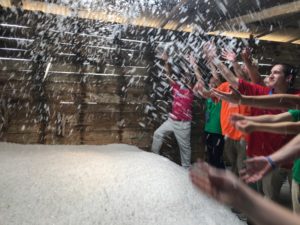We started off the day with our daily morning announcements and the plan for the day ahead. But before we met in the morning, some of us went on a jog to the beautiful pier about half a mile from the Outreach360 compound.
After the run everyone freshened up with a quick Navy-style shower. Then, we all met for breakfast. Breakfast was amazing. It consisted of pan tostado or toast, huevos rancheros, a dish made with scrambled eggs and vegetables, and piña or pineapple. For the less adventurous, there was also cereal con leche or cereal with milk. The daily peach tea and water were offered, along with the delicious Dominican coffee.
After eating breakfast we made our way to the school, arriving just as recess started. Some of us played wall ball with the children (a more painful version than our American version), while other played basketball or tag. Our last day in the classroom was by far the best day for all of us. Our lesson plan for class was more solid and we knew how to encourage the students to participate in activities. Overall we found that relationships and trust play a big part in teaching. Both the students and the teachers have to trust themselves and each other. We also developed more respect for our teachers in school, who worked tirelessly to plan out our lessons and make classes interesting. After teaching at the school, we headed back to the Outreach360 compound. For lunch we had pollo frito (fried chicken), arroz com frijoles rojos (rice with red beans), and once again, piña. We also had a special hot chocolate drink made without milk. After eating lunch, we had a Siesta, our rest time, for an hour. With our energy replenished, we began walking to the salt flats.
At the salts flats Miguel, a Dominican and volunteer at Outreach360, gave us a tour. He took us through the stages of producing salt. Salt production is a very big part of Dominican industry and is critical to the health of their economy. The process went like this: First, water from the ocean was drawn into a reservoir where it began with twenty degrees of salinity. Then workers would direct water to the heating part by opening certain gates. Here some of the water evaporates and the salinity doubles to forty degrees. From here it would move to the crystallization stage, the hottest stage at which the salt crystallizes. In this stage the salinity levels also double again. Workers then transported piles of salt in wheelbarrows to shacks where it dried.
After going to the salt flats we finished our day in the learning center. For fifteen minutes we read with the students with bilingual, or completely English books. We then moved into the classrooms inside of the Outreach360 compound and taught the students about rooms in a house and important objects in those rooms. We did this by drawing houses, playing “hangman,” and other games. The students then took a written test. Once they were finished they came out of the classrooms and played games like basketball, and four square with us.
We had an amazing dinner of tacos made of ground beef, corn, rice, beans, and tomatoes. We also had fresh pineapple juice to drink for dinner. Lastly, we prepared for our trip to the Dominican Republic-Haiti Border by listening to a lecture and watching a riveting documentary. –Sebastian Singh and Neil Malik
Today on June 14, 2018 marked the final day of teaching the children. We began our morning with breakfast at 8 o’clock to prepare for the day. An hour later, we headed to the public school to teach vocabulary about food. Though the two sessions went well, the group had to say its goodbyes to the children with whom we recently made close bonds. After lunch, we walked up the street to tour the salt flats, which comprises the main sector of the Montecristi economy. Telling us about how the salt beds function, Miguel walked us through the reservoir where salt water collects. We concluded the tour with a stop at a souvenir shop where many people bought items to remember the journey. Upon arriving back, we set up the Outreach360 building as a learning center for a separate group of children. The children came in eager to read to us, however, reading time was cut short due to testing. Once reading time ended, the level one students were taught about different shapes and rooms. Testing followed, consisting of a listening section and a short writing section. Yet another goodbye occurred as we had to say farewell to the friends we met at the learning center. After the kids left, we prepared for the best dinner: tacos. Satisfied by the amazing dinner, we sat for an important discussion about racial relations on Hispaniola. Then we watched a documentary on the Haitian Dominican relationship and how it came about. –Mihir Damle
